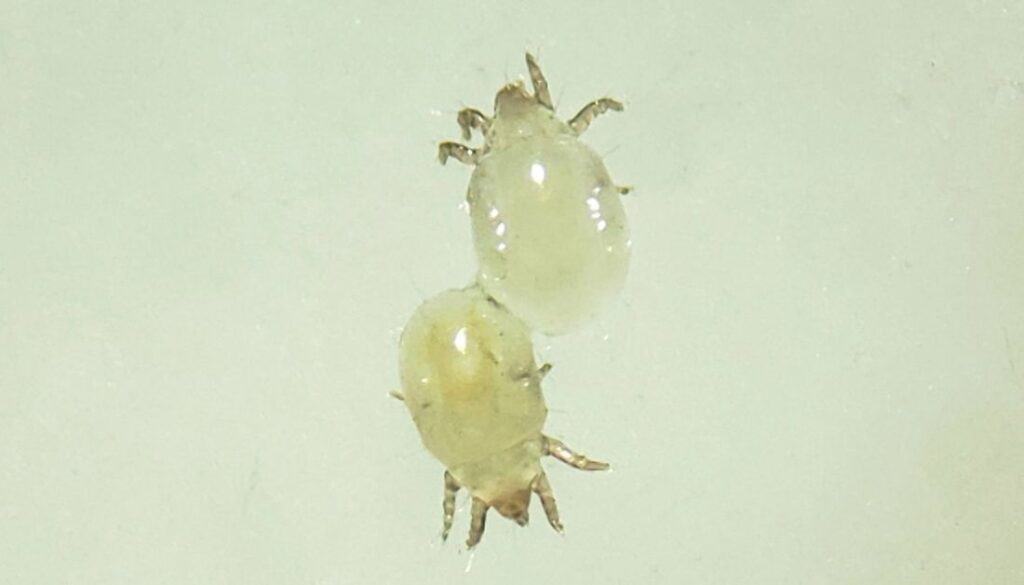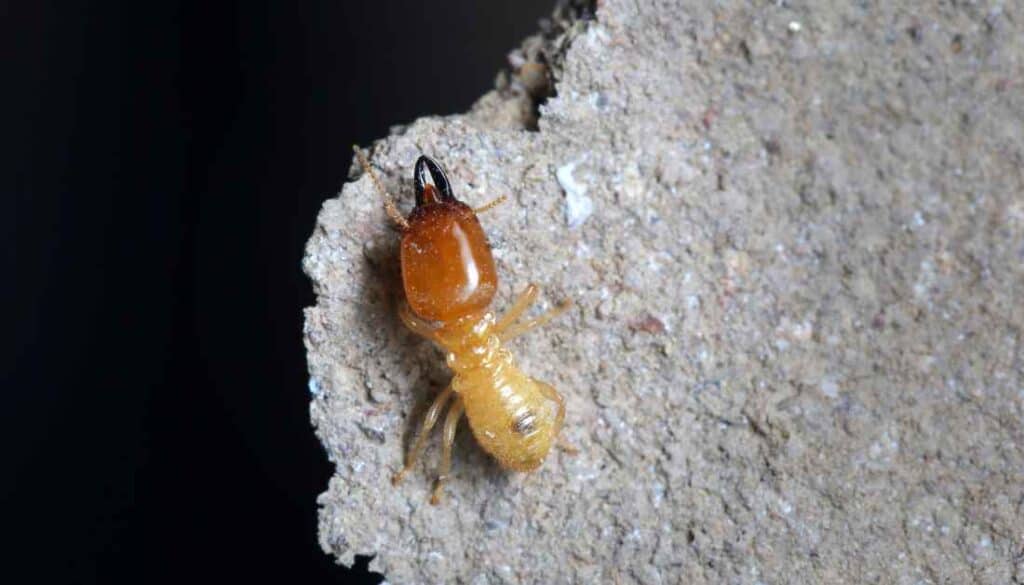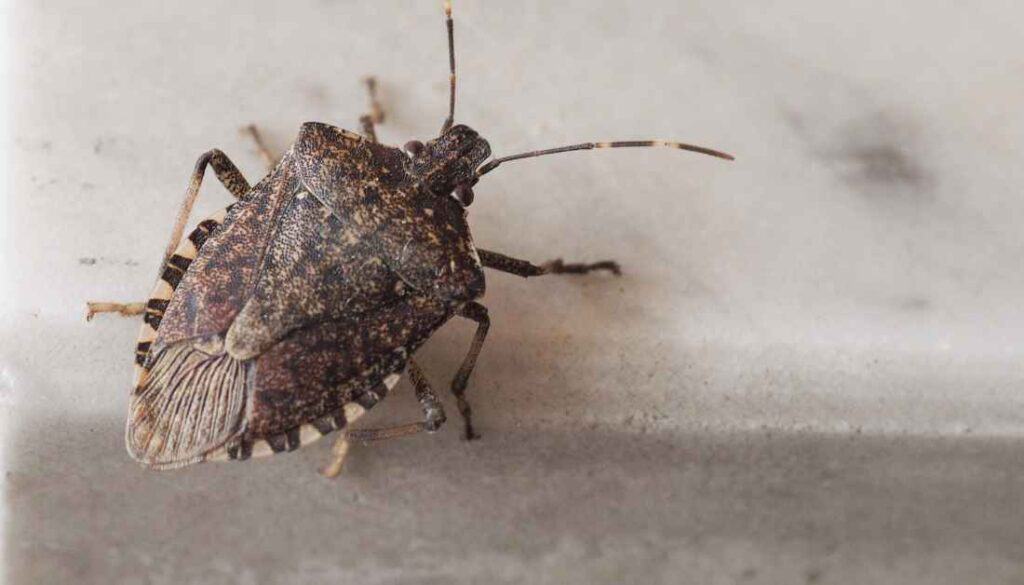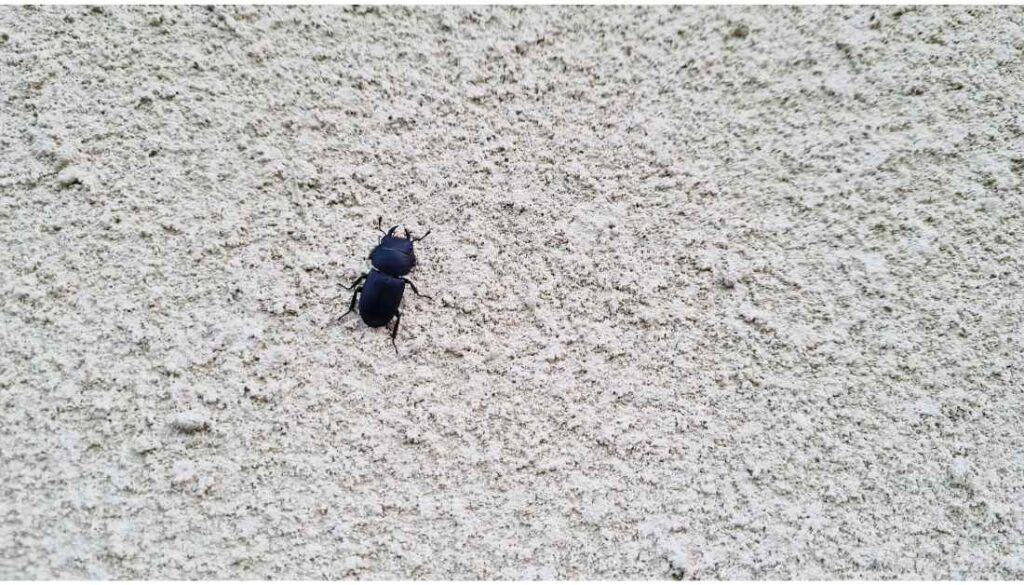Your home’s walls and ceiling are vital organs, and the bugs in them are ominous symptoms of a hidden disease.
I discovered the hard way that tiny bugs on walls and ceilings are a critical health warning for your living space.

My experience and online research took me deep into the rabbit hole of this strange occurrence to unravel the secrets behind these wall bugs.
What I found was shocking but made complete sense.
The revelation that wall bugs like termites and ants could jeopardize the home’s structural integrity was particularly alarming.
In this guide, I’ll reveal the 20 wall and ceiling bugs and the reasons for their presence.
I’ll also share the simplest ways to bid farewell to them and prevent them from returning to your walls.
Let’s dive right in to understand this critical issue plaguing your home.
Mold Mites

Mold mites are common on damp walls, ceilings, and furniture with molds and fungi.
These mites feed on these molds, and they multiply pretty fast.
Mold mites are so tiny that they are impossible to spot when their numbers are low.
When they multiply, these mites appear as large clusters of brown, gray, or white dots crawling on walls, ceiling corners, and surfaces.
Use a mold cleaner to clean and repair the walls, and take measures, such as installing a dehumidifier, to control the dampness in the house and eliminate and prevent mold mites.
Mold mites don’t bite but can trigger allergic reactions in sensitive individuals.
Wall Mites

Another sign of excessive dampness in the house is wall mites on the walls and ceiling.
Wall mites, known as psocids or booklice, climb walls to feed on the molds.
These voracious mold eaters can target books, drywall, stored grains such as rice, and cardboard boxes if they’ve mold or fungi.
Wall mites are tiny, soft-bodied, clear white, brown, or gray. They’re oval-shaped and appear as slow-moving bugs on the walls.
Wall mites don’t cause any structural damage to the house.
But they can multiply quickly and you start to notice them not just on walls but also on grains and paper products.
Also, booklice can create panic because of they resemble termites.
Dust Mites

Dust mites are microscopic bugs that enter homes from the outdoors.
A gust of wind can bring them inside through the open windows. They can also sneak inside the house through the cracks in the windowsills and walls.
Dust mites in the house will settle on dusty and moist surfaces such as damp walls, floors, furniture, and ceilings.
They can also live on soft furnishings such as carpets, drapes, curtains, rugs, and bed mattresses.
Like mold mites, dust mites are also challenging to see when their numbers are low.
When their numbers increase, they appear as a layer of white dust on the surface.
Dust mites are terrible allergens. They can enter our respiratory system and trigger allergic reactions such as sneezing, runny nose, and itchy eyes.
Dust mites can be deadly for asthma patients because they can trigger asthma attacks in them.
Another nasty thing that dust mites do is that they feed on dry human skin. Their feeding leads to itchy rashes and welts on the skin.
Vacuum cleaning the home daily during the dust mite season and washing clothes and fabric in hot soapy water are the only defenses against dust mites.
Termites

Termites can cause structural damage to your home by drilling into the walls and ceilings.
Subterranean termites attack homes from underground. They build tubes from the ground level up to the floors, walls, and ceilings.
Another termite species, dry wood termites, specifically target the structural lumber of the house, such as wooden ceilings, roofs, joists, and beams.
They invade homes as winged termites by flying in through the open windows.
I don’t recommend any DIY solutions to get rid of termites in the house. In my experience, it’s impossible to eliminate termites by yourself.
Treatment with boric acid and diatomaceous earth works only when the infestation is minor.
So, please hire a termite exterminator if you see termites and their signs in the house.
Carpet Beetle Larvae

Carpet beetle larvae climb up on the walls and ceilings to feed on spider webs and dead insects stuck in the wall voids.
The larvae are dark brown hairy worms with tapered bodies.
And they’re infamous for feeding on natural fibers such as wool, silk, feathers, and fur.
Their feeding habits cause extensive damage to woolen carpets and expensive garments made from natural fabrics.
The hairy bristles on their bodies can cause itching if they crawl onto your skin. This skin condition is known as carpet beetle dermatitis.
The possibility of these larvae crawling onto your skin is high if there’s a carpet beetle infestation in the house.
The carpet beetle larvae also crawl onto beds to feed on the bed’s fabric while searching for food and hiding places.
Clover Mites

Clover mites are tiny red bugs that invade homes from the outdoors during the fall and spring. They look like tiny red spiders because of their two long frontal legs.
These bugs live in overfertilized grass lawns and on properties with clover trees.
They sneak inside the house through the windows.
And they spread randomly on walls, floor, and even your bed.
Clover mites don’t bite. And they can’t breed inside the house.
So, there’s no way that they can cause an infestation.
However, these bugs can be a big nuisance in the house because they enter in droves.
Another worst thing about clover mites is that they produce reddish stains if you crush them.
And these red stains can be challenging to remove, especially on fabrics like bed sheets.
It’s best to control clover mites in your grassy lawns where they hide.
Sealing the cracks in the windows also prevents them from entering the home.
Vacuum cleaning the house removes clover mites. But be careful. You should not crush them while vacuuming.
Bed Bugs

Bed bugs can spread to your home’s walls if the infestation is severe.
Bed bugs typically hide in beds and inside any crevice within 6-8 feet of the bed.
But when their numbers are high, they look for alternative hiding places.
That makes them occupy any thin hole, aperture, or void on walls, furniture, and windowsills.
Seeing bed bugs on walls is a bad sign. You must inspect your rooms thoroughly for bed bugs.
I’d suggest hiring a pest controller for bed bug treatment if you’ve found bed bugs and their signs in the house.
Fleas

The case of fleas on the walls is the same as the bed bugs.
Their numbers shot up in the house, and you see fleas in unusual areas such as walls and floors.
Pets bring fleas home. But wildlife such as raccoons and skunks can bring fleas with them.
You can also bring fleas home if you’ve been to a flea habitat like tall grassy areas or in a flea-infested home.
So, a home without pets can also have fleas.
Fleas in the home can and will feed on human blood, too.
They can hide in places like beds and couches where they can easily access human skin.
Treating the pet for fleas and a home-wide flea treatment eliminates fleas from the house.
Stink Bugs

Stink bugs enter homes during winter while looking for a warm place to overwinter.
They will hide in the wall voids in places like the attic, basement, and other cluttered areas of the house.
They emerge from their hiding places when spring arrives.
But some of them can die in the wall and ceiling voids. Their carcasses can draw bugs like ants that feed on them.
Stink bugs can bite if you try to handle them. But these bugs secrete a chemical that produces a nasty odor.
That’s their way of self-defense from any threat or predation.
Pavement Ants

Pavement ants are infamous for building their nests in concrete pavements. But they can also do the same on the walls.
Pavement ants will invade homes from the outdoors by sneaking through the wall voids.
And they’ll pick up a crack or crevice on the walls and ceiling to build their colonies.
Pavement ants are dark brown to black and shorter than the carpenter ants.
Pavement ants in walls and ceilings will attack your kitchen for food.
You can notice them moving in ant trails that lead to a food source or a nesting site in the walls.
These ants spread quite fast. And soon, they can spread in the entire home if you don’t get rid of them.
Drain Flies

Drain flies are tiny moth-like flies that breed in the bathroom and kitchen drains.
These flies lay hundreds of eggs in the slime, choking the drains.
Tiny white worms, which are also known as drain worms, hatch out of these eggs.
These worms mature into adult drain flies. And the adults pop out of the drain holes.
Drain flies are common in the bathroom, kitchen, basement walls, and ceilings.
Their presence on the walls and ceiling indicates your home has drainage and decaying organic matter problems.
Fungus Gnats

Fungus gnats are small black flies that look like mosquitoes. But they don’t bite.
These flies are not strong fliers and can only fly short distances.
They have a short zig-zag flight pattern that makes fungus gnats appear more like jumping bugs rather than flies.
Fungus gnats in the house will lay their eggs in the potting soil of houseplants and on the decaying organic matter blocking the drains.
So, like drain flies, fungus gnats are visible on the walls and ceilings of bathrooms and kitchens.
These flies are nuisance flies. And they’ve got an irritating knack for following humans.
They’re attracted to light. So, they can appear in places like bedrooms and living rooms without moisture or food sources.
Fungus gnats don’t bite, and they don’t spread any diseases either.
Fruit Flies

Fruit flies are tiny tan flies with black markings on their abdomen and with red eyes.
Fruit flies enter the kitchen by flying in through the windows.
Smells of overripe or rotting fruits and vegetables and food waste in the house draw fruit flies.
They’ll lay eggs in the food wastes, in ripe fruits, and even inside appliances like dishwashers and coffeemakers.
Like drain flies, fruit flies can also lay eggs inside the drains.
All these hidden sources of fruit flies in the house can trigger a fruit fly infestation in the home.
You’re most likely to see fruit flies on the walls and ceiling of your kitchen and sinks and counters.
But they can appear in random areas such as bedrooms and living rooms if the fruit fly infestation is severe.
Pantry Moths

Pantry moths, which are also known as Indian meal moths or rice moths, are dark-colored moths that invade homes to lay eggs on stored foods.
These moths fly inside the house through open windows during the summer when they’re active.
Pantry moths don’t bite. Pantry moth larvae hatch from the eggs that the adult moths lay on stored foods such as rice, flour, and cereals.
The larvae damage the stored foods by feeding on them, leaving behind their fecal matter and shed skin.
So, if you notice a moth on your kitchen’s walls and ceiling, it’s a rice moth that has invaded your kitchen.
Plaster Bagworms

Plaster bagworms are worms with cases on their back. These cases are made from their saliva.
As these worms drag the cases along, debris gets stuck on the cases. And these cases get a dirty grayish look.
The moisture in the walls attracts the plaster bagworms.
But these worms also feed on the dead insects in the wall voids and spider webs on the walls and ceiling.
Vacuum cleaning the walls is the best way to remove the plaster bagworms on walls.
These worms don’t bite. But they can feed on clothes specially made from natural fibers because they’re the larvae of clothes moths.
Plaster bagworms are also known as case-bearing worms because of the cocoons they drag with themselves.
Common House Fly

The common house flies are gray with four black stripes on their thorax.
These flies are 0.25 inches and common on walls and ceilings of homes with house fly infestations.
Open garbage cans, rodent and insect carcasses in the wall voids, decaying organic matter in the yard, and pet feces attract these house flies.
House flies are attracted to human food. These flies can transfer the germs on their bodies to human food.
These germs can cause food poisoning and salmonella.
Maggots

Maggots on walls are the larvae of flies that might have laid eggs on the dead insects in the wall voids.
But these maggots are larvae of flies such as fruit flies and drain flies.
The larvae of these flies feed on the molds and mildew. So their larvae can venture out of their breeding grounds to feed on them.
One instance is the sighting of drain fly larvae or drain worms on the shower grout of the bathroom.
The larvae venture out of the drain holes to feed on the wastes stuck in the shower tiles.
Many homes with damp walls and fly infestations notice these maggots on their home’s walls, floors, and ceilings.
Fungus Beetles

Fungus beetles is a collective term that covers various beetle species that feed on the molds and fungi on the walls and ceiling.
Pest controllers call these beetles plaster beetles because many newly built homes with damp plasters on the walls get these beetles.
Fungus beetles come in different colors, such as brown, yellow, and black.
And thankfully, they’re not home-damaging pests.
Centipedes

Centipedes, the scary-looking long insect with many legs, are experts in hiding inside the crevices on the walls and floor.
When I had a nasty centipede infestation in my bathroom, I saw these insects crawling out of the wall cracks and sneaking in the crevices on the shower floor.
But centipedes avoid human contact. So, they hide in areas like the bathroom and the basement where there’s a lot of dampness and clutter.
They’re venomous. So, I don’t recommend handling them because centipedes can bite.
Springtails

Another bug that you can spot on the bathroom’s walls is the springtails.
These tiny cylindrical jumping bugs are moisture-seeking insects that sneak inside the bathroom when the weather outdoors becomes too hot and dry.
Springtails can climb walls to sneak inside the house through the cracks in the walls and windows.
Springtails feed on the molds and debris on the walls, but they pose no threat.
These are harmless insects that jump if you try to kill them.
However, they can breed in the bathroom and can cause an infestation.
Silverfish

Silverfish are tiny scaly insects with tapered bodies. They’ve a pair of antennae and three appendages at their rear end.
Silverfish bugs are also attracted to walls and ceiling with cracks, debris, and dampness.
As these bugs need moisture to survive, so, the most common places where they hide are bathrooms, basements, and kitchens.
Silverfish don’t bite. But they bring significant risks to books, stored foods, and fabrics.
Eliminating silverfish can be a tricky affair if you don’t remove the moisture sources.
So, in addition to using chemical and natural methods to get rid of silverfish, you’ll also need to fix the leaky pipes that are causing moisture issues.
Proper ventilation of places like bathroom and kitchen is also needed to control humidity.
FAQs
What Causes Bugs in Walls and Ceilings?
It depends on many factors such as moisture in the walls, wall voids, and things like molds and debris on the walls and ceilings.
Bugs will be in walls and ceilings if there are food sources and hiding places in them.
Insects like termites and pavement ants can drill inside the walls to build colonies or to reach their food sources.
How to Get Rid of Bugs In Walls and Ceilings?
Using a bug spray on the insects on walls and ceilings will kill the bugs.
However, you’ll need to fix the sources, such as water leakages, which are causing the walls and ceilings to become damp.
Using a dehumidifier in the house also helps in controlling the dampness because of excessive humidity.
Dampness causes molds and creates wall cracks. Both give an opportunity to bugs to feed and hide.
Plus, you’ll also need to hire a pest control professional depending on the type of bugs you’re seeing on the walls and ceiling.
The worst part is that if bugs are on your walls, then it’s a clear sign that they’re in other areas of the house.
Will Bugs on Walls and Ceiling Go Away on Their Own?
No, they won’t. They’re on the walls for a reason.
Once they’re done with feeding and nesting on the walls, they’ll continue to spread in the rest of the areas of their house.
Some bugs on the walls and ceilings are at the larval stages of their adults.
If you don’t control them, then these larvae will mature into adults and breed further inside the house.
That will certainly aggravate the infestation in the house.
References:
- Studies on Termite Infestation in Building, The Journal of Applied and Basic Zoology.
- Pests in Excessively Damp Locations, University of California, Riverside.
- Fungus Beetles, Ohio State University


